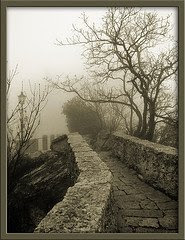Can we travel through time and alter our destiny?
2) What happened in 1955 that changed Ronald Mallett's life forever?
In 1955 Mallett's father died. Mallet was ten years old.
3) What inspirational book did Mallet read in 1956?
In 1956 came across The Time Machine and became obsessed with the idea of building a time machine. He wanted to go back into time and save his father's life.
4) He also read Einstein. What key points about the relationship between space, time, light and gravity did he learn?
For Einstein space and time are connected. Space and time are like a fabric or sheet. Objects can warp this fabric and gravity is the effect of this warping.
5) What are the implications for time travel knowing that gravity can twist time into a loop?
You can generate gravity to twist time into a loop and thus create a pathway to moving backwards and forwards in time.
6) In the 1980's studying time travel was not taken seriously. Mallett therefore decided to another branch of physics as 'a cover'. Explain what is meant by 'a cover' in this context, and then say what mallet's cover was.
A cover is a disguise, a way of concealing someone's true intentions. Mallett studied black holes to conceal his true interest which was time travel.
7) What is a black hole?
A collapsed stars that has immense gravity. They distort both space and time.
8) Einstein's famous equation e=m2 desrcibes the relationship between light and matter and that they are different forms of the same thing. Listen to ronald mallet explain the relationship between light, gravity and time. Now complete the following:
Gravity __________ time.
Light _______ gravity.
Then light can _______ time.
Gravity affects time.
Light creates gravity.
Then light can affect time.
In other words: Light affects time because light creates gravity and gravity affects time.
9) Describe Mallet's time machine
The machine is made up of four intersecting laser beams. They generate a circulation effect which creates a tunnel of light. These circulating beams twist the space and time with in its perimeter.
10) Who or what will the first time traveller be?
The first time traveller will be a particle, either a neutron or information information.
11) What is the significance of being able to send information back into the past?
It makes it possible to inform the past about about future disasters and how to avoid them.
12) Use Mallett's analogy of the coffee cup to explain how his time machine works.
The spoon is like the light beam which makes the liquid swirl around. You can see the swirling
effect by placing a coffee bean into the coffee. Imagine when the bean is placed into the coffee this is the past. It is carried to the present then into the future and returns to its starting point which is the past. So the caffee bean has moved from the future to the past.
13) With Mallett's time machine how far back into the past will it be possible to travel?
The furthest particles or information or eventually a human being could be sent back into the past is to the point when the time machine was first switched on. So Mallet could never have the ability to travel back in time to save his father.
14) How could an advanced alien civilization help us travel to the very distant past to witness say the building of the pyramids in Egypt?
If another civilisation had acquired the technology say 10,000 years ago and had it switched on all that time then it would be possible.
15) How much does Mallett need to finance the construction of his time machine?
$250,000 , a quarter of a million dollars.
16) What is the 'grandfather paradox'?
This means going back into the past, changing something that affects your future existence.
17) The grandfather paradox may not be a problem due to the possible existence of parallel universes – explain this 'far out' notion.
Changing the past may not be a problem for the present owing the possible existence of mulitple parallel universes. For example once the past is changed it continues on its own trajectory into the future. This leads to the idea that alternative universes can generated by time travellers going into the past to change the future.


